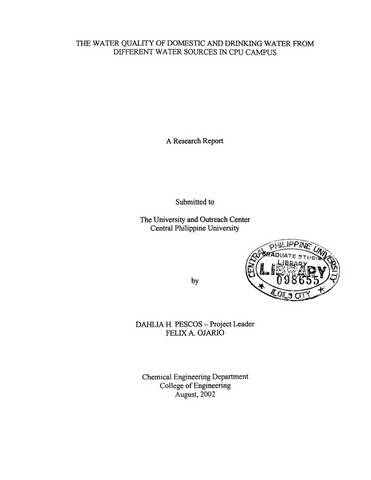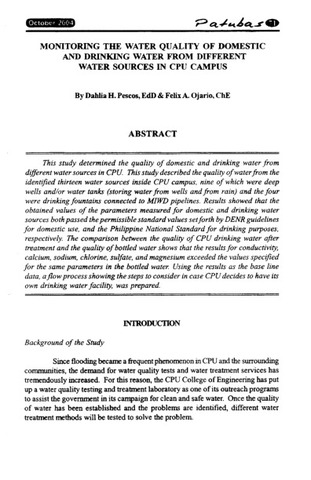Показать сокращенную информацию
The water quality of domestic and drinking water from different water sources in CPU campus
| dc.contributor.author | Pescos, Dahlia H. | |
| dc.contributor.author | Ojario, Felix A. | |
| dc.date.accessioned | 2021-08-12T07:15:58Z | |
| dc.date.available | 2021-08-12T07:15:58Z | |
| dc.date.issued | 2002-08 | |
| dc.identifier.citation | Pescos, D. H. & Ojario, F. A. (2002). The water quality of domestic and drinking water from different water sources in CPU campus (Research report). Jaro, Iloilo City: University Research Center, Central Philippine University. | en_US |
| dc.identifier.uri | https://hdl.handle.net/20.500.12852/1303 | |
| dc.description | Abstract only | en_US |
| dc.description.abstract | This study determined the quality of domestic and drinking water from different water sources in CPU. The parameters tested were color, temperature, pH, dissolved oxygen, total dissolved solids, conductivity, turbidity, acidity and alkalinity. Bacteriological analysis was also included. The study also tested additional parameters such as chlorine, magnesium, sulfate, sodium, calcium, and biological oxygen demand of one sample taken from a deep well suspected to contain chemicals and biological contaminants being near the life science and chemistry laboratories. Furthermore, it also determined the capability of the present water laboratory of the College of Engineering for water quality testing. There were thirteen water sources identified for study inside the CPU campus. Of these, nine were deep wells and four were drinking fountains connected to Metro Iloilo Water District (MIWD) pipelines. Tests on parameters like temperature, pH, dissolved oxygen, total dissolved solids, conductivity, turbidity, acidity and alkalinity were performed in the College of Engineering water laboratory. Tests on biological oxygen demand (BOD) and color were done in the Department of Energy and Natural Resources (DENR) water laboratory. Tests for chlorine, magnesium, sulfate, sodium, and calcium were conducted in the Department of Science and Technology (DOST), Region 6, water laboratory. Bacteriological analysis was done in Western Visayas Medical Center (WVMC). Results showed that the obtained values of the parameters measured for the nine deep wells inside CPU campus passed the permissible standard values set forth by DENR guidelines for domestic use. Water treatment was no longer needed if the water from these sources are used for washing, cleaning and bathing purposes. Further, results also showed that the obtained values of the parameters measured for the four drinking fountains connected to MIWD pipelines passed the permissible Philippine National Standard for drinking water (the same standard used by the MIWD). This research, in its attempt to give CPU an insight whether to put up its own drinking water station, decided to make use of the quality of water from sampling station # 2 as the based line data for the quality of domestic sources and compared it with the quality of bottled water. Sampling station # 2 has the capacity to supply the raw water needed for the project and has a strategic location in CPU campus. Results showed that only the concentrations of magnesium and sulfate salts exceeded that of the bottled water. For its treatment, the water was allowed to pass an ion exchange apparatus and was allowed to stay in the laboratory for three days before retests for magnesium and sulfate were conducted. Results showed that the treatment applied was a success because the concentration of the said salts have decreased below that of the bottled water. The research also compared the quality of water from drinking fountains to the quality of bottled water. Results have shown that calcium, sodium, chlorine, sulfate and magnesium content of water from sampling station # 12 exceeded that of the bottled water ranging from 70 to 96%. With these results, a flow process on what steps to consider on having our very own drinking water facility was also included. A recommendation for another research on the design of a water treatment facility system inside CPU campus was made to further treat the raw water coming from identified sources to ensure that the students of a safe and potable drinking water. | en_US |
| dc.format.extent | ix, 82 leaves | en_US |
| dc.language.iso | en | en_US |
| dc.publisher | Central Philippine University | en_US |
| dc.subject.ddc | GSL 628.72072 P437 | en_US |
| dc.subject.lcsh | Water quality | en_US |
| dc.subject.lcsh | Water quality--Measurement | en_US |
| dc.subject.lcsh | Drinking water | en_US |
| dc.subject.lcsh | Drinking water--Analysis | en_US |
| dc.subject.lcsh | Central Philippine University | en_US |
| dc.title | The water quality of domestic and drinking water from different water sources in CPU campus | en_US |
| dc.title.alternative | The water quality of domestic and drinking water from different water sources in Central Philippine University campus | en_US |
| dc.type | Technical Report | en_US |
| dcterms.accessRights | Limited public access | en_US |
| dc.description.bibliographicalreferences | Includes bibliographical references | en_US |
| local.relation.associatedcontent | https://repository.cpu.edu.ph/handle/20.500.12852/689 Full paper published in Patubas | en_US |
Файлы в этом документе
Данный элемент включен в следующие коллекции
-
Research reports [13]
-
Research reports [167]





